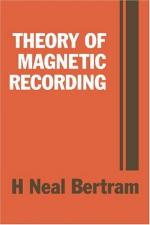|
This section contains 987 words (approx. 4 pages at 300 words per page) |

|
Magnetic recording is the technique of storing electric signals as a magnetic pattern on a moving magnetic surface. The concept of recording sound on magnetic tape--and thus the principle of the tape recorder--was worked out theoretically in an 1888 article by the English inventor Oberlin Smith (1840-1926). The article, entitled "Several Possible Developments of the Phonograph," proposed using fabric strips containing iron filings as "tapes." It was, however, 10 years later that Smith's ideas were adapted and the first working magnetic tape recorder was introduced. In 1898, 20-year-old Danish inventor and physicist Valdemar Poulsen created a device that recorded and reproduced sounds by residual magnetization of a steel wire. The telegraphone, as it was called, was demonstrated at the 1900 World Fair in Paris, but the world took little notice of the new technology at the time. The invention of magnetic recording tape is variously attributed to J. A. O'Neill...
|
This section contains 987 words (approx. 4 pages at 300 words per page) |

|


